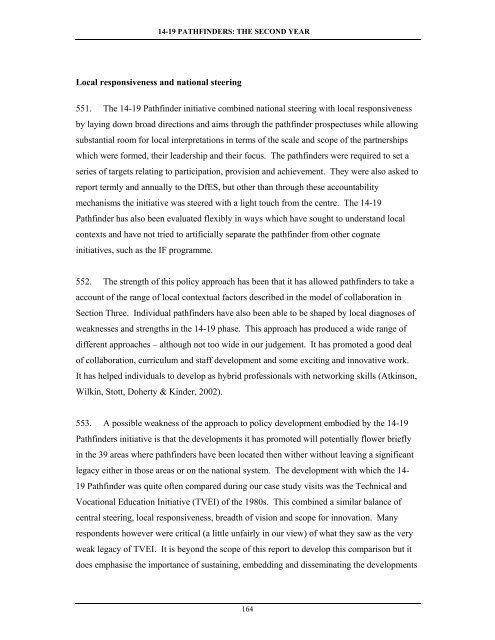Collaborative Approaches to 14-19 Provision - Communities and ...
Collaborative Approaches to 14-19 Provision - Communities and ...
Collaborative Approaches to 14-19 Provision - Communities and ...
- No tags were found...
Create successful ePaper yourself
Turn your PDF publications into a flip-book with our unique Google optimized e-Paper software.
<strong>14</strong>-<strong>19</strong> PATHFINDERS: THE SECOND YEARLocal responsiveness <strong>and</strong> national steering551. The <strong>14</strong>-<strong>19</strong> Pathfinder initiative combined national steering with local responsivenessby laying down broad directions <strong>and</strong> aims through the pathfinder prospectuses while allowingsubstantial room for local interpretations in terms of the scale <strong>and</strong> scope of the partnershipswhich were formed, their leadership <strong>and</strong> their focus. The pathfinders were required <strong>to</strong> set aseries of targets relating <strong>to</strong> participation, provision <strong>and</strong> achievement. They were also asked <strong>to</strong>report termly <strong>and</strong> annually <strong>to</strong> the DfES, but other than through these accountabilitymechanisms the initiative was steered with a light <strong>to</strong>uch from the centre. The <strong>14</strong>-<strong>19</strong>Pathfinder has also been evaluated flexibly in ways which have sought <strong>to</strong> underst<strong>and</strong> localcontexts <strong>and</strong> have not tried <strong>to</strong> artificially separate the pathfinder from other cognateinitiatives, such as the IF programme.552. The strength of this policy approach has been that it has allowed pathfinders <strong>to</strong> take aaccount of the range of local contextual fac<strong>to</strong>rs described in the model of collaboration inSection Three. Individual pathfinders have also been able <strong>to</strong> be shaped by local diagnoses ofweaknesses <strong>and</strong> strengths in the <strong>14</strong>-<strong>19</strong> phase. This approach has produced a wide range ofdifferent approaches – although not <strong>to</strong>o wide in our judgement. It has promoted a good dealof collaboration, curriculum <strong>and</strong> staff development <strong>and</strong> some exciting <strong>and</strong> innovative work.It has helped individuals <strong>to</strong> develop as hybrid professionals with networking skills (Atkinson,Wilkin, S<strong>to</strong>tt, Doherty & Kinder, 2002).553. A possible weakness of the approach <strong>to</strong> policy development embodied by the <strong>14</strong>-<strong>19</strong>Pathfinders initiative is that the developments it has promoted will potentially flower brieflyin the 39 areas where pathfinders have been located then wither without leaving a significantlegacy either in those areas or on the national system. The development with which the <strong>14</strong>-<strong>19</strong> Pathfinder was quite often compared during our case study visits was the Technical <strong>and</strong>Vocational Education Initiative (TVEI) of the <strong>19</strong>80s. This combined a similar balance ofcentral steering, local responsiveness, breadth of vision <strong>and</strong> scope for innovation. Manyrespondents however were critical (a little unfairly in our view) of what they saw as the veryweak legacy of TVEI. It is beyond the scope of this report <strong>to</strong> develop this comparison but itdoes emphasise the importance of sustaining, embedding <strong>and</strong> disseminating the developments164
















